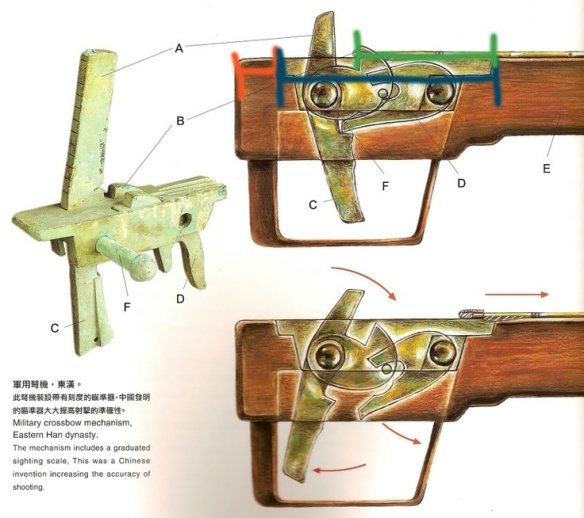Above is medieval trigger, below is Han trigger
The hand-held crossbow, a mainstay of Chinese armies from the fourth century BCE onward, was also known and used in Japan, but neither the ritsuryo armies nor the bushi appear to have developed much interest in it, preferring to rely instead on the long bow. The ritsuryo military statutes provided for only two soldiers from each fifty-man company to be trained as oyumi operators, and no later source indicates that this ratio was ever increased. Hand-held crossbows and crossbowmen are not mentioned in the statutes at all. It is, of course, possible that the term “oyumi” in the ritsuryo codes and other sources referred to handcrossbows, as well as ballista-like ones, but this is improbable, for several reasons.
First, while source references to crossbows of any form are scant, two documents do clearly distinguish oyumi from “hand-crossbows” (shudo). The first, a report concerning a bandit raid on the Dewa provincial office in 878, discloses that among the items destroyed or stolen were “29 oyumi” and “100 shudo.” The second, an inventory from the Kozuke provincial office compiled around 1030, lists “25 shudo” (apparently its entire stock) as missing. The specific identification of “hand-crossbows” in these documents strongly suggests that the term “oyumi” here and in earlier sources referred to something else. The reading “oyumi” (“great bow”) itself is also evocative of a large, rather than a hand-held, weapon.
Second, hand-crossbows require very little skill to operate – in fact this is their principal advantage over the long bow. And yet more than two-thirds of the extant sources that mention oyumi (indeed, virtually all such references from the ninth century) complain of the dearth of men capable of using the weapon or training others to use it Third, archaeologists have, to date, unearthed only one trigger mechanism for a hand-crossbow, despite more than a century of efforts. That more have not been discovered, and that none had been discovered at all until the late 1990s, is strong testimony to the rarity of the weapon in Japan.
And finally, positing more than an incidental presence for hand-held crossbows in early military forces necessitates an explanation for their virtual disappearance during the early tenth century. William Wayne Farris, the only scholar to date to argue that hand-crossbows once played a significant role in Japanese warfare, attributes their decline to “high technological requirements” and other difficulties involved in manufacturing the weapons, which made them prohibitively expensive for private ownership. This thesis, however, rests on an exaggeration of the relative difficulty involved in making the weapons.
Crossbows are ingenious devices, but they are not particularly complex. The simplest designs require only two moving parts in addition to the stock and the bow itself. The trigger mechanism recently discovered in Miyagi prefecture, and nearly identical to those used in Han China, had three moving parts.
Chinese craftsmen cast the parts for the trigger in bronze, and then carefully fi led and worked them to the precise fit necessary to make the mechanism function smoothly. Japanese trigger mechanisms appear to have been similarly made. This process required an impressive level of workmanship and a considerable investment in labor, but it was no more difficult or expensive than the methods applied to produce swords, arrowheads, armor and other manufactured goods that continued to find a market long after enthusiasm for crossbows of any sort evaporated.
The technological problem that would have most vexed Japanese artisans concerned not the trigger but the bow stave, an issue not of craftsmanship but of available materials, and one that would not have been affected one way or another by the withdrawal of direct government involvement in the manufacturing process. For the same limited choices of construction materials that determined the development of the distinctive Japanese long bow would have complicated the design and manufacture of hand-crossbows as well.
The bow staves of Chinese crossbows were composites of wood, bone, sinew and glue, constructed in much the same manner as the ordinary Chinese bow. But, as we have observed, the Japanese lacked supplies of animal products, and fashioned their bows from wood and bamboo instead, which required that the weapons be long.
Manufacturing crossbows with composite bow staves of wood and bamboo comparable in length to those of regular bows would have resulted in a weapon too unwieldy to be practical: not merely extraordinarily wide – and not readily usable by troops standing in close ranks – but also extraordinarily long, as it would have been necessary to lengthen the stock to permit a sufficient draw. Crossbows made with either short wood or wood and bamboo bow staves would have been considerably weaker, and more prone to breaking or delaminating, than the regular bows already in use.
